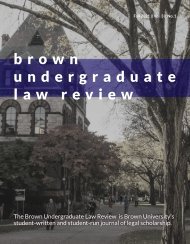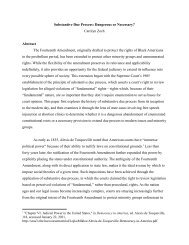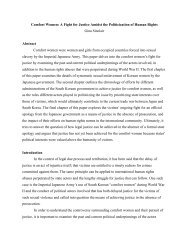Brown Undergraduate Law Review — Vol. 2 No. 2 (Spring 2021)
We are proud to present the Spring 2021 issue of the Brown Undergraduate Law Review. We hope that the works contained herein offer insight and inspiration to all who read them.
We are proud to present the Spring 2021 issue of the Brown Undergraduate Law Review. We hope that the works contained herein offer insight and inspiration to all who read them.
Create successful ePaper yourself
Turn your PDF publications into a flip-book with our unique Google optimized e-Paper software.
Standardizing Autonomy: Medical Communication, Liability, and the Doctrine of Informed Consent<br />
years prior to Canterbury, in Nishi v. Hartwell (1970), the<br />
supreme court validated informed consent as a tort cause<br />
of action yet affirmed a trial court?s dismissal of the case<br />
because Plaintiff Nishi had failed to ?adduce expert<br />
concept of what a patient needs to hear is an insufficient<br />
metric by which to determine an individual patient?s<br />
informational needs. 75 While expert testimony would still<br />
be required to demonstrate the materiality of medical risk,<br />
medical testimony? to prove the inadequacy of following Carr v. Strode Hawaiian courts no longer invited<br />
physician-Defendant Dr. Hartwell?s disclosure. 72 Faced<br />
with a similar case in Carr v. Strode, however, Hawaii?s<br />
Supreme Court embraced Canterbury to overrule the<br />
state?s informed consent precedent, contrasting Indiana?s<br />
stubborn rejection of the patient standard that Canterbury<br />
medical professionals to establish the scope of reasonable<br />
disclosure on their patients?behalf.<br />
Alabama?s case of Fain v. Smith (1985) illuminates the<br />
challenge of legally defining not only reasonable<br />
disclosure, but reasonable consent on the patient?s<br />
sought to advance. Despite their pre-Canterbury<br />
behalf? particularly in the wake of a distressing medical<br />
application of the reasonable physician standard in Nishi v.<br />
Hartwell, Hawaii?s Supreme Court reversed the circuit<br />
court judge?s JNOV in Carr v. Strode and remanded the<br />
case for a new trial on the issue of informed consent, citing<br />
Canterbury?s reasoning as well as a ?growing nationwide<br />
trend [reflected in Hawaii?s lower court decisions] favoring<br />
the patient-oriented standard.? 73<br />
In their comparison of the physician- and patient-oriented<br />
standards, the Carr court opined that both ?seek to achieve<br />
the same goal? of ?[ensuring] informed and intelligent?<br />
patient decision-making. 74 Ideally, the scope of disclosure<br />
dictated by each standard would align in keeping with this<br />
shared aim. Still, acknowledging the significant difference<br />
between the two means of judging physicians?conduct, the<br />
court explained its choice to adopt the patient standard in<br />
Carr v. Strode by arguing that the medical community?s<br />
mistake. The Alabama Supreme Court heard the appeal of<br />
Plaintiff Duncan Fain, whose heart was erroneously<br />
punctured during a pulmonary arteriogram. After Fain?s<br />
informed consent case against physician-Defendant Dr. R.<br />
T. Smith was decided in Dr. Smith?s favor by a district<br />
court jury, on appeal Fain held that the jury had applied the<br />
wrong standard to assess proximate causation. 76 While<br />
Fain and Dr. Smith concurred that the risk of heart<br />
puncture should have been disclosed prior to the<br />
procedure, the two parties disputed whether Dr. Smith?s<br />
inadequate disclosure actually caused Fain?s injury: If Fain<br />
had been properly informed, would it have altered his<br />
decision to undergo the diagnostic test? Fain argued that<br />
the district court should have employed the subjective<br />
standard, by which the plaintiff?s own testimony<br />
constitutes sufficient proof that ?he would not have<br />
72. Ibid., 904 P.2d 494. (?Because Nishi had failed to adduce expert medical testimony regarding what physicians in the community disclosed to<br />
their patients regarding the particular medical procedure, we affirmed the trial court?s dismissal of Nishi?s complain, and by so holding, adopted the<br />
?physician-oriented?standard of disclosure for actions based on the doctrine of informed consent.?)<br />
73. Ibid., 904 P.2d 499.<br />
74. Carr v. Strode, 904 P.2d 498. (?Both standards, therefore, tempered by objectivity, seek to achieve the same goal, that is, to ensure that the<br />
patient?s decision to undergo a particular medical procedure is an informed and intelligent decision.?)<br />
75. Ibid., 904 P.2d 499. (?Moreover, not only should the patient?s decision remain at the forefront when assessing the physician?s disclosure to his or<br />
her patient in each case, but we also believe that, barring situations where the therapeutic privilege exception to the physician?s duty to disclose is<br />
applicable, what the medical community believes the patient needs to hear in order for the patient to make an informed decision is insufficient,<br />
without more, to resolve the question of what an individual patient reasonably needs to hear in order for that patient to make an informed and<br />
intelligent choice regarding the proposed medical treatment.?)<br />
76. Fain v. Smith, 479 So. 2d 1154. (?Plaintiffs contend in brief that the objective standard does away with consideration by the jury of the patient?s<br />
testimony concerning his thoughts.?)<br />
<strong>Brown</strong> <strong>Undergraduate</strong> <strong>Law</strong> <strong>Review</strong><br />
42










